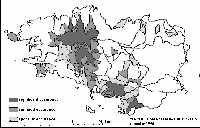 |
Last Update:
Friday November 23, 2018
|
| [Home] |
|
Volume 8 Pages 1 - 47 (February 1993) Citation: Lafontaine, L. (1993) Distribution of Lutra lutra in Brittany and First Preventative Measures against Road Traffic. IUCN Otter Spec. Group Bull. 8: 37 - 39 Distribution of Lutra lutra in Brittany and First Preventative Measures against Road Traffic Lionel Lafontaine LutrAtlantica, B.P. 1, 29670 Locquenolé, France. Phone: +33 871 527 061 Email: llionel.lafontaine@orange.fr http://www.reseau-loutres.org
Otters, absent or very rare from the north, most of the east and the southeast of France, are relatively widespread on the Atlantic coast and in the Massif Central. Supported by the French ministry of Environment, World Wildlife Fund and many other financial backers, a National Action Plan has been introduced in 1989 by the Société Française pour l'Etude et la Protection des Mammifères. This paper is a summary of a report which is a contribution to this Action Plan and has been published in 1991 for the Direction Régionale de l'Environnement in Brittany (Lafontaine, 1991). DISTRIBUTION OF OTTERS A regional survey has been carried out from 1986 to 1990 in order to update previous data (cf IUCN OSG Bulletin 3). More than one hundred people took part, most of them observing the standard survey method described by MacDonald (1990). Distribution of otters, displayed by subunits of river catchments and by occurrence levels (see map), showed that the species still occupies the third - mainly inland - of this country; 76% of positive subunits show a good or very good water quality1, while 7 % of them, mainly southwestern wetlands from the Atlantic coast, show bad water quality. Adversely - but not surprisingly - otter signs were not recorded in catchments where low flowing water quality is very bad (east and northwest, of the country).
Coastal and insular otters still remain on the west end south coasts, but become restricted in range. The Molène Archipelago (Regional Park of Armorique), recently labelled Man and Biosphere Reserve, holds the most westerly and unusual population.. Extrapolating occupied areas by occurrence levels, mean numbers of otters in Brittany have been estimated between 150 and 250 individuals, that is to say about 25 % of the total French strength. Recent data suggest a re-colonisation process in subunits adjacent to the central core. PREVENTATIVE MEASURES AGAINST ACCIDENTAL MORTALITIES From 1986 to 1990, 22 otter road mortalities have been recorded in the country; this is the first known mortality factor but other ones2 (e.g. poaching, mink and nutria trapping, rodents poisoning...) are probably underestimated. Following useful advice from R. Green (Vincent Wildlife Trust, U.K.) or A.B. Madsen (National Forest and Nature Agency, Denmark), and road works schemes increasing drastically, a large consultation has started with national or departmental road authorities, in order to suggest and provide preventive measures. The 1976 Nature Conservation Act has planned this obligation for protected species but it had never been enforced for otters. For the first time In France:
Ordered by the French Ministry of Environment, a survey is now in progress in order to test the respective efficiency of these underpasses. Further cooperation should be welcome with foreign experiences. A technical seminar (including also otter accounting during hydraulic works and wetland management) will be arranged during autumn 1993 to show these achievements. People interested in attending have to write to; Direction Régionale de l'Environnement, 10 rue des Dames, F-35000 Rennes, France. REFERENCES Lafontaine, L. (1991). La loutre et la route. Groupe Mammalogique Breton, Parc Naturel Régional d'Armorique (report 1st part, 114 p.) NOTES 11981-88 Basin Agency Survey, including several criteria (mainly organic and bacteriological), but not pesticides and PCBs contamination. 2No true evidence has allowed to accredit the fact that beavers could significantly undermine otter populations, which seem healthy where the single beaver colony has been reintroduced. |
| [Copyright © 2006 - 2050 IUCN/SSC OSG] | [Home] | [Contact Us] |
